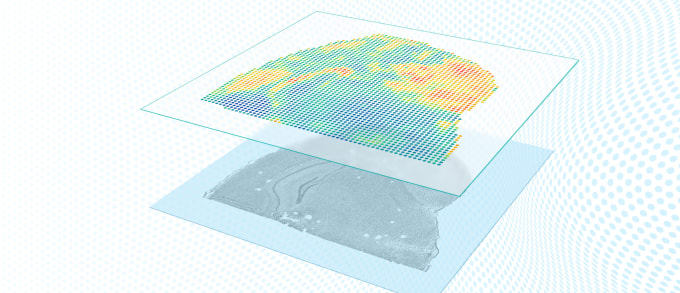How will spatial gene expression transform clinical translational research?
The Visium Spatial Gene Expression Solution has the potential to aid in many clinical translational research applications, including biomarker discovery, engineered immune cell therapy, and clinical trial development. Join the Visium Clinical Translational Research Network to gain exclusive access to a collaborative, global research community dedicated to accelerating clinical translational research workflows. This is the last week to enter the program. Submissions are due by March 31, 2020, 11:59pm PST.

Spatial gene expression provides crucial insight into the relationship between cells and their relative locations within a tissue sample. However, we’ve only just begun to recognize its applications and understand its clinical impact. Critical to understanding mechanisms of human disease, spatial gene expression could be key in developing therapeutic interventions and evaluating the basis of therapeutic response in clinical trials.
Recently, a group of researchers at NYU Langone Health studying pancreatic ductal adenocarcinoma (PDAC) combined single cell RNA sequencing (scRNA-seq) with spatial gene expression profiling. While powerful on their own, the combination of these methods enabled the researchers to develop a comprehensive, unbiased study of PDAC tumors, allowing them to identify cell types and populations that were locally enriched in specific tissue sections. scRNAseq provided key information about tumor heterogeneity at single cell resolution while spatial gene expression revealed the spatial organization of these cells. Taken together, these two methodologies elucidated the complex relationships between cellular function, phenotype, and location.
Their results have far-reaching implications. The combination of scRNA-seq and spatial gene expression represents an important new method for analyzing complex tissue architecture and cellular interaction. Further, since tumor composition varies from patient to patient, understanding the cellular heterogeneity of a tumor in conjunction with its spatial structure may play a role in disease prognosis and precision medicine. Read the study to learn more.
This type of study is an example of clinical translational research, where scientists connect data and information collected in a laboratory setting to clinical practice, potentially informing patient care, medical studies, and future treatments. And there is much to be learned about how spatial gene expression will play a role in clinical medicine.
The Visium Spatial Gene Expression Solution allows researchers to analyze the whole transcriptome in a fresh-frozen tissue section and map where that gene expression is occurring in the morphological context of the tissue, overcoming the limitations of traditional tools that rely on a few validated antibodies or probes. It has the potential to aid in many clinical translational research applications, including biomarker and drug target discovery, engineered immune cell therapy, and clinical trial development. And we want to support this research. That’s why we’re developing the Visium Clinical Translational Research Network (CTRN), a collaborative, global research community dedicated to accelerating clinical translational research.

This is the last week to apply to the CTRN and become part of a world-class group of scientists furthering the adoption of spatial gene expression in clinical translational workflows. Completed applications are due no later than March 31, 2020, 11:59pm PST, so don’t miss your chance to join this collaborative community of researchers.
Find out more about the Visium Clinical Translational Research Network.
